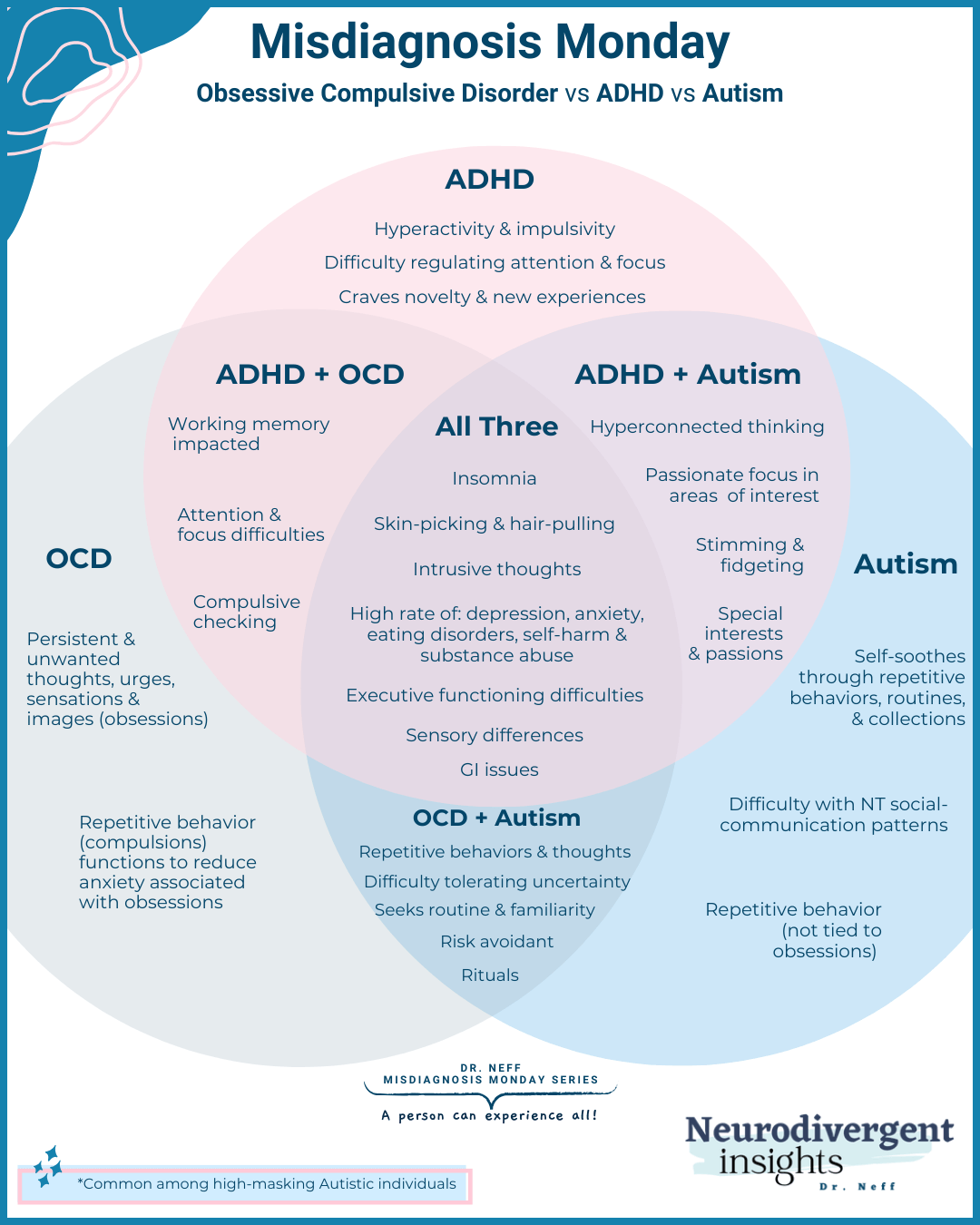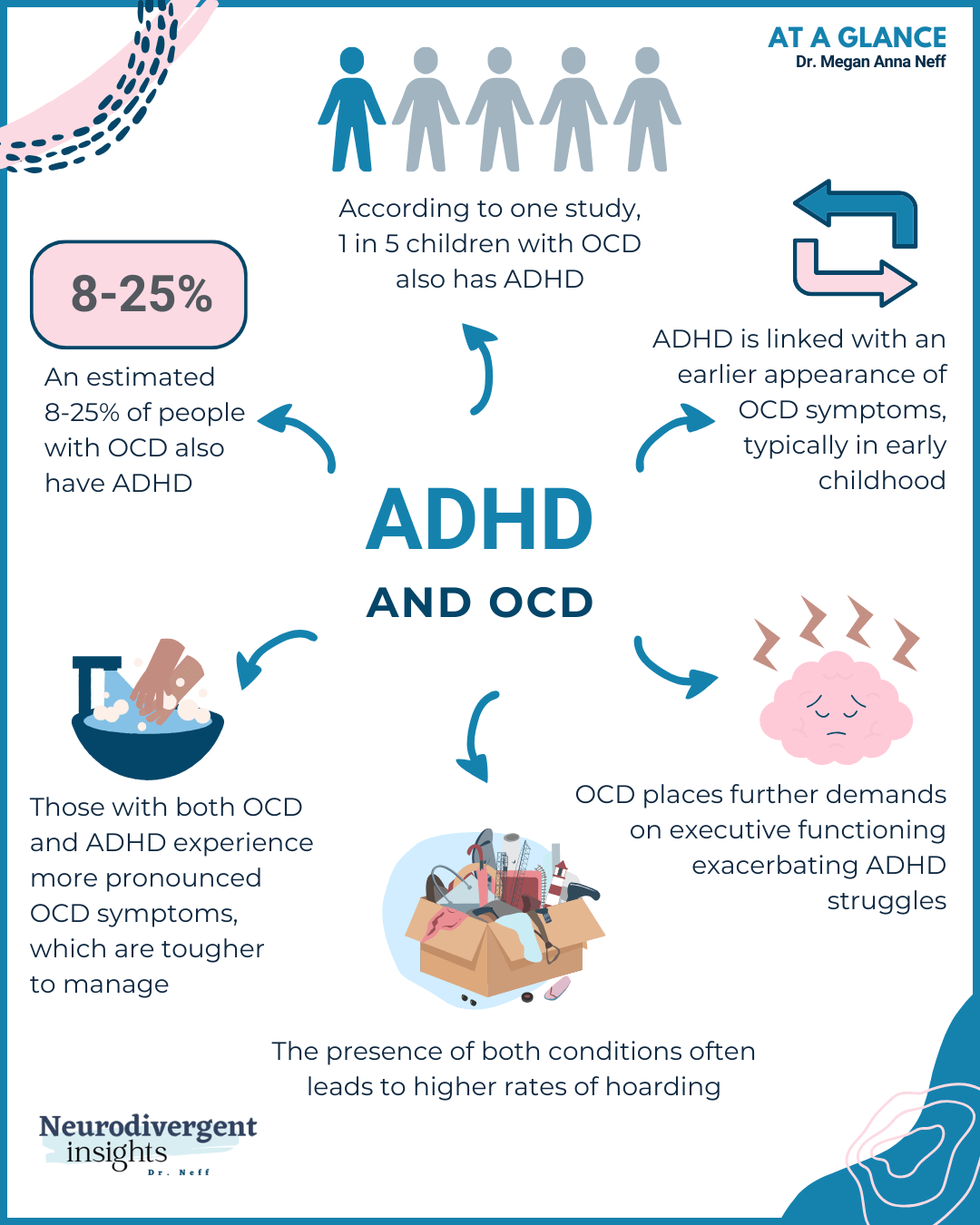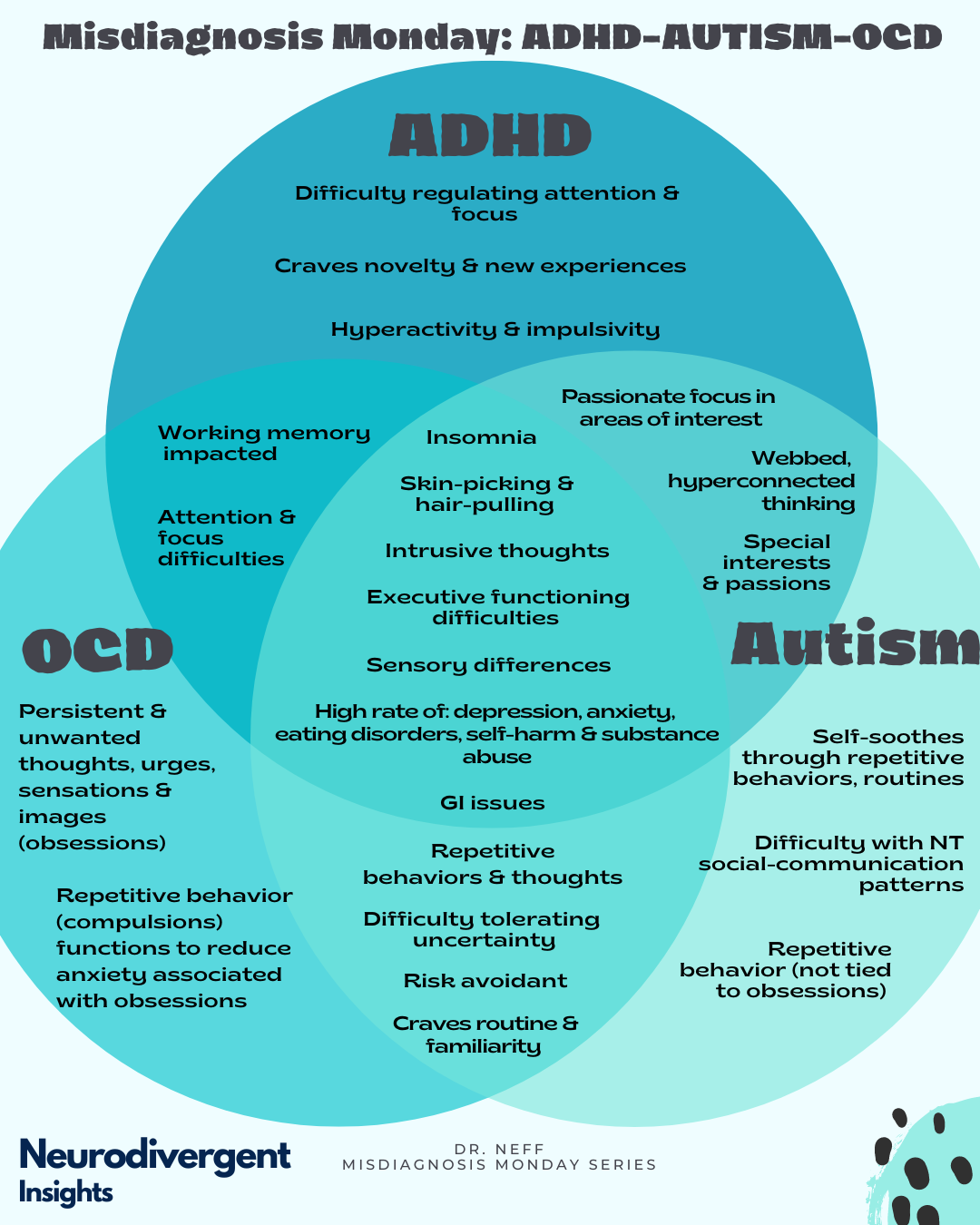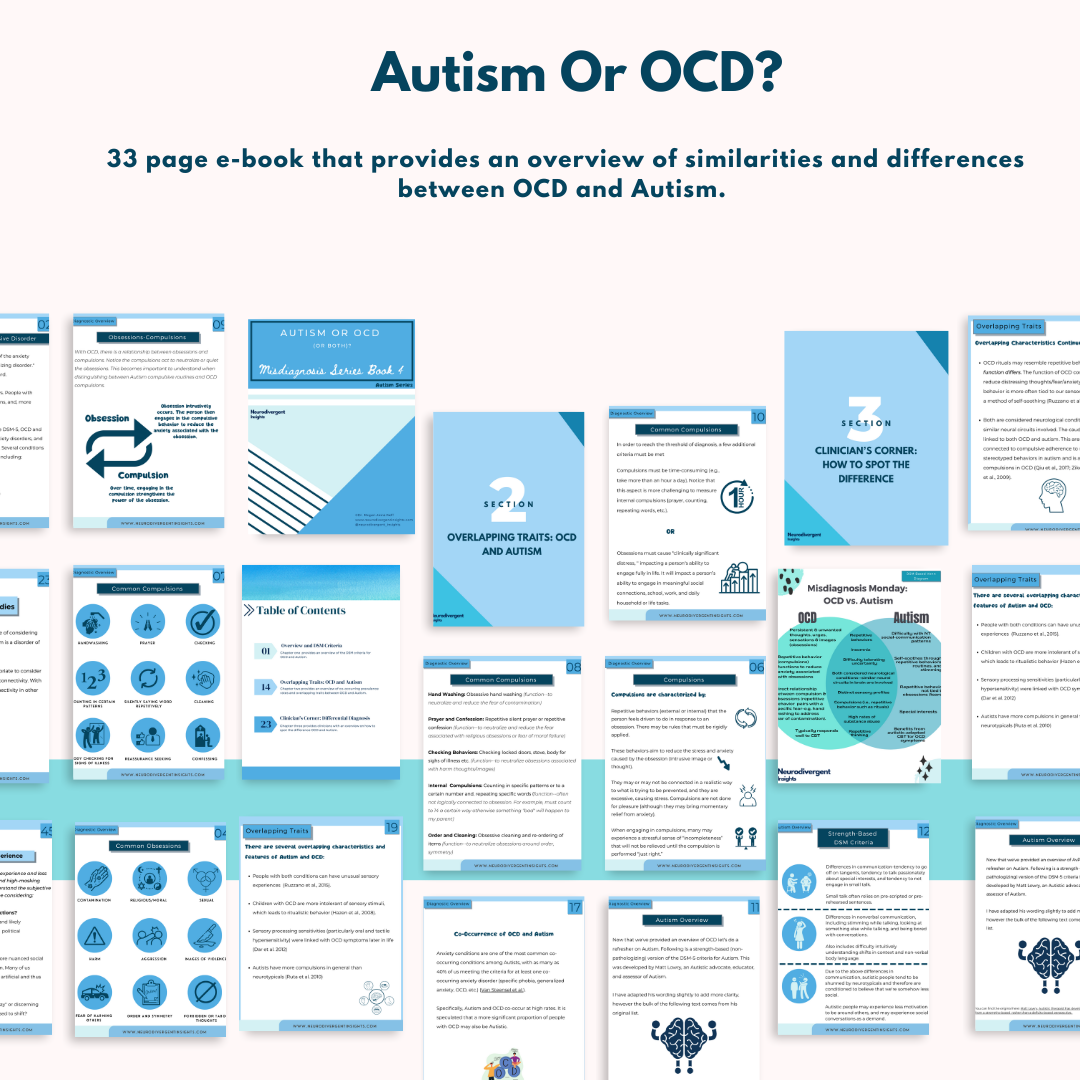ADHD-Autism-OCD
In the evolving conversation around neurodiversity, the nuanced overlaps between Autism, ADHD, and OCD have garnered attention, prompting a deeper exploration into how these conditions intersect and diverge. Responding to the community’s call, I’ve developed a triple Venn diagram to visualize the complex interplay among these conditions, a reflection not just of curiosity but of the pressing need for greater understanding and accurate recognition.
Navigating the Diagram:
At the Core: Here, we map out traits common to all three conditions, shedding light on the diagnostic challenges that often confound experts and those living with these conditions alike.
Intersecting Areas: These segments reveal traits that two of the conditions share, providing insight into their overlap and the potential for misdiagnosis or missed diagnosis.
The conversation around diagnosis has long centered on the issue of misdiagnosis, yet an equally critical challenge lies in missed diagnoses. It is all too common for an individual to be identified with one condition while others remain obscured, a reality that complicates the path to understanding and support. For instance, an accurate diagnosis of OCD might overlook concurrent ADHD or Autism, leaving significant aspects of a person’s neurodivergence unaddressed.
This visual representation seeks to unpack the reasons behind the frequent misdiagnosis or partial diagnosis of ADHD, OCD, and Autism. Considering their high rates of co-occurrence, it becomes clear that a nuanced understanding of these overlaps is essential. The likelihood of individuals with ADHD or Autism also experiencing OCD is significantly higher than that of the general population, a fact that underscores the complexity of neurodivergent experiences.
Through this diagram, we aim to contribute to a more informed dialogue on the intersections of these conditions, emphasizing the critical need for comprehensive assessment and understanding. This endeavor reflects a step towards demystifying the complexities inherent in neurodivergence, with the hope of fostering a more inclusive and accurate narrative around diagnosis.
Co-Occurrence Rates for ADHD, Autism, and OCD
OCD affects 2 to 3 percent of Americans (American Psychiatric Association, 2022) with studies demonstrating that OCD is familial, partially due to genetic factors (Pauls, 2022). For folks with neurodivergence, particularly ADHD, rates of OCD is much more prevalent. Complicating matters, there is also a high degree of overlap between Autism and ADHD. So let’s explore the prevalence rates of co-occurrence.
How Often do ADHD and OCD Co-Occur?
Research reveals a significant overlap between Obsessive-Compulsive Disorder (OCD) and Attention Deficit Hyperactivity Disorder (ADHD), underscoring the prevalence of their co-occurrence. Here are the pivotal findings:
Up to 30% of individuals with OCD may also have ADHD, highlighting the significant overlap between these conditions (Brem, 2014).
Among people with ADHD, 17% to 25% exhibit symptoms of OCD (Masi, 2010).
ADHD is notably the most common concurrent condition in cases of early onset OCD, emphasizing the importance of monitoring for both conditions in young patients (Brem, 2014).
One study found that one in five children with OCD also had ADHD (Abramovitch and Mittelman; 2013).
In adults with OCD, 1 in 12 are believed to have ADHD as well. This figure is thought to be an underestimate, particularly for those with the inattentive type of ADHD, suggesting potential underdiagnosis (Olivardia, 2021).
A detailed study of 94 children and adolescents with OCD found that 25.5% had ADHD, while another study reported a 17.1% co-occurrence rate, reflecting significant pediatric overlap (Masi, 2006; Masi, 2010).
In a study involving 155 people with OCD 11.8% met definite criteria for ADHD, and an additional 8.6% had probable ADHD (a total of 20.4%). Research also observed that those with ADHD were more likely to have hoarding disorder (41.9% compared to 29.2 of non-ADHD people with OCD) (Sheppard et al., 2010).
You can read more about the overlap of ADHD and OCD here.
How Often do Autism and OCD Co-Occur?
Research also indicates a substantial overlap between Autism and OCD. Here’s a simplified overview based on recent studies:
It is speculated that a larger proportion of people with OCD are Autistic. A population-based study in Denmark found familial links between OCD and Autism. Additionally they found that Autistic people had twice the risk of being diagnosed with OCD later in life (Meier et al., 2015).
Conversely, people with OCD are four times more likely to receive an Autism diagnosis at some point, suggesting a deeper link than previously understood (Meier et al., 2015).
Nearly half of those with OCD show significant Autistic traits, and over a quarter meet the criteria for an Autism diagnosis, pointing to a considerable overlap that may include many undiagnosed cases (Wikramanayake et al., 2018).
A study in the UK (Wikramanayake et al., 2018) involving 73 adult outpatient patients with OCD measured Autistic traits using the Autistic Quotient (AQ) and found that 47% scored above the clinical threshold. It is speculated that a larger proportion of people with OCD may also be Autistic.
You can read more about the overlap of OCD and autism here.
How Often do ADHD and Autism Co-occur?
Additionally, ADHD and autism also co-occur at high rates. Here’s a simplified overview based on recent studies:
It is estimated that between 22-83% of Autistic children meet the criteria for ADHD (Sokolova et al., 2017).
Approximately 30-65% of ADHD children have significant Autistic traits Sokolova et al., 2017.
Twin and family studies consistently show substantial genetic overlap between the two conditions. There is approximately a 50-72 % overlap of contributing genetic factors Sokolova et al., 2017.
While co-occurrence is common, it is also common to see elevated ADHD traits within Autistics or elevated Autistic traits within the context of ADHD. A person may not meet the criteria of both and yet still have significant trait overlap. I suspect that “pure ADHD” or “pure Autism” is the exception, not the norm.
You can read more about the overlap of ADHD and autism here.
Navigating ADHD Routines, Autistic Rituals, and OCD Compulsions
Given the significant overlap among conditions, distinguishing between behaviors related to Autism, ADHD, and OCD can be challenging. For clinicians, it's crucial to understand these intersections and the differences between compensatory strategies, rituals, and compulsions to fully support clients and ensure they receive the most suitable treatment.
Here’s a brief overview of how these experiences differ:
ADHD and Routines: People with ADHD often depend on routines to bolster executive functioning. These routines act as a crucial scaffold, aiding in stress and anxiety management. Disruption to these routines can exacerbate stress, indicating that these are pragmatic, designed more for navigating daily life than fulfilling any ritualistic or compulsive need.
Autistic Rituals: For Autistic individuals, rituals are vital for sensory regulation and creating predictability. These rituals offer comfort, serving as an end in themselves rather than a means to avoid negative outcomes. This contrasts with OCD compulsions, as Autistic rituals are not performed out of fear but as positive, self-soothing actions that address sensory needs.
OCD Compulsions: OCD compulsions, conversely, are closely linked with obsessions and are performed to prevent negative outcomes. They're marked by the belief that certain actions are necessary to avoid harm, such as thinking, "If I don’t perform this ritual, something bad will happen." Unlike the self-soothing nature of Autistic rituals, OCD compulsions are a response to anxiety and fear, offering temporary relief but not pleasure or comfort.
Understanding these distinctions is key to connecting with and effectively supporting each person on their unique journey. It's about more than categorizing behaviors; it's about understanding individual needs and tailoring our support accordingly. The journey to effective therapy for OCD can be long, with Ziegler (2021) noting it can take around 12 years for adequate treatment, which underscores the importance of accurate diagnosis and treatment strategies.
Dive Deeper into Understanding
The interplay between ADHD, Autism, and OCD is complex and nuanced, with each condition carrying its own complexities and nuances. For those keen on exploring the subtle distinctions and overlaps further, I've compiled a series of in-depth articles. Each piece is designed to peel back the layers of how these conditions interact, offering further insights into their unique and shared characteristics.
ADHD vs. Autism: Uncover the unique and overlapping characteristics of ADHD and Autism, providing insights into their distinct and shared traits. Explore the deep dive.
ADHD vs. OCD: Investigate the interplay between ADHD and OCD, shedding light on how these conditions can mimic each other and what sets them apart. Dive deeper.
Autism vs. OCD: Delve into the relationship between Autism and OCD, understanding the commonalities and differences that define their co-occurrence. Read the in-depth article here.
Each article is crafted to give you an understanding of how these conditions intersect and differ. These articles aim to provide you with the insights needed to identify both the distinct and shared symptoms, helping to navigate the complexities with greater clarity.







